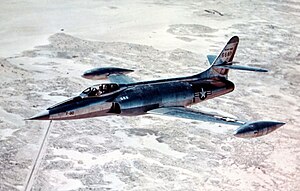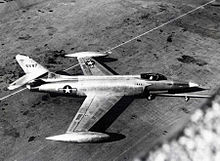| XF-90 | |
|---|---|
| XF-90 in flight | |
| Role | Fighter |
| Manufacturer | Lockheed |
| Designed by | Willis Hawkins Clarence L. "Kelly" Johnson |
| First flight | 3 June 1949 |
| Status | Cancelled |
| Number built | 2 |
| Unit cost | US$5.1 million for the program[1] |
Contents
|
Design and development
After a redesign from its original delta planform, the Lockheed Model 90 was built as a mock-up in 1947.[2]The final design featured 35° sweptback wings, a sharply-pointed nose and two Westinghouse J34-WE-11 axial-flow turbojet engines, providing a total thrust of 6,200 lbf (27.6 kN),mounted side-by-side in the rear fuselage and fed by side-mounted air intakes. [3]The wings had leading-edge slats, Fowler flaps and ailerons on the trailing edge. The pressurized cockpit was fitted with an ejector seat and a bubble canopy. Proposed armament was six 20 mm (.79 in) cannons. The internal fuel was supplemented by wingtip-mounted tanks, bringing total fuel capacity to 1,665 gal (6,308 l). The use of 75ST aluminum rather than the then-standard 24ST aluminum alloy, along with heavy forgings and machined parts, resulted in an extremely well-constructed and sturdy airframe. However, these innovations also resulted in an aircraft which had an empty weight more than 50 percent heavier than its competitors.[3]The first XF-90 used J34s without afterburning, while the second (XF-90A) had afterburners installed; these were tested on an F-80 testbed, yet the aircraft remained underpowered. [3]
Testing and evaluation
The XF-90 was the first USAF jet with an afterburner and the first Lockheed jet to fly supersonic, albeit in a dive. It also incorporated an unusual vertical stabilizer that could be moved forward and backward for horizontal stabilizer adjustment. Because Lockheed's design proved underpowered, McDonnell's XF-88 won the production contract in September 1950.Upon Lockheed losing the production contract, the two prototypes were retired to other testing roles. The first aircraft (46-687) was shipped to the NACA Laboratory in Cleveland, Ohio in 1953 for structural tests. It was no longer flyable, and its extremely strong airframe was tested to destruction. The other (46-688) survived three atomic blasts at Frenchman Flat within the Nevada Test Site in 1952. The XF-90 lived on in popular culture as the aircraft of the "Blackhawks" comic book.
In 2003, the heavily damaged hulk of the second XF-90A (46-688) was recovered from the Nevada test site and moved to the National Museum of the United States Air Force in Dayton, Ohio. It is currently undergoing minor restoration in one of the Museum's restoration facility hangars. Its wings have been removed, and its nose is mangled from the nuclear blasts. During the decontamination process, all the rivets had to be removed to remove radioactive sand. At present, the museum plans to display the XF-90 in its damaged, mostly unrestored condition, to demonstrate the effects of nuclear weaponry.
Specifications (XF-90A)
General characteristics- Crew: One
- Length: 56 ft 2 in (17.12 m)
- Wingspan: 40 ft 0 in (12.20 m)
- Height: 15 ft 9 in (4.80 m)
- Wing area: 345 ft² (32 m²)
- Empty weight: 18,050 lb (8,204 kg)
- Loaded weight: 27,200 lb (12,363 kg)
- Max takeoff weight: 31,060 lb (14,118 kg)
- Powerplant: 2× Westinghouse J34-WE-15 turbojets, 4,100 lbf (18.2 kN) each
- Maximum speed: 665 mph (1,064 km/h)
- Range: 2,300 mi (3,680 km)
- Service ceiling: 39,000 ft (11,890 m)
- Rate of climb: 5,555 ft/min (28.2 m/s)
- Wing loading: 79 lb/ft² (386 kg/m²)
- Thrust/weight: 0.30
- 6 × 20 mm (.79 in) cannons
- 8 × 5 in (127 mm) HVAR rockets
- Up to 2,000 lb (907 kg) of bombs
 Unknown
Unknown










0 komentar:
Post a Comment